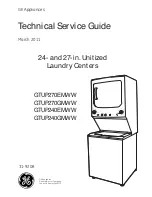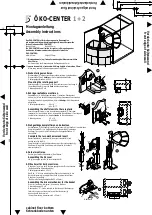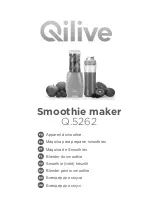
7
TURNING ON YOUR WINE COOLER
Plug in and switch on the unit by pressing the power button
for a few seconds.
When you use the wine cooler for the first time (or restart the wine cooler after having it shut off for a long
period), there will be a few degrees variance between the temperature you have selected and the one
indicated on the LED display. This is normal and it is due to the length of the activation time. Once the wine
cooler is running for a few hours everything will stabilize.
Important: If the unit is unplugged, power is lost, or turned off, wait 3 to 5 minutes before restarting the
unit. The wine cooler will not start if you attempt to restart before this time delay.
OPERATING NOISES
The noise level is very low. Both the compressor and the fan has a very low noise level during normal
operation. The compressor can run at different speeds. This saves energy. Higher compressor speed is used
to increase the cooling capacity, for example at initial switch on, the thermostat’s set point is lowered, or if
the door has been open. When the correct temperature is reached or wine bottles are cooled the compressor
will again run at reduced speed and have a very low noise level. During start-up, the compressor will always
run with maximum speed. This provides a higher level of noise until the set temperature has been reached.
To obtain the desired temperature settings, this wine cooler, like all wine coolers operating with compressors
and fans, may produce the following types of noises.
The noises are normal and may occur as follows:
Gurgling and hissing sound - caused by the refrigerant flowing through the appliance’s pipes and nozzles.
Cracking/popping sounds - resulting from the contraction and expansion of the refrigerant gas to produce
cold.
Fan operating sound - to circulate the air inside the wine cooler.
LOADING YOUR WINE COOLER
You may load your wine bottles in single or double rows while taking the following into consideration: If
you do not have enough bottles to fill your wine cooler entirely, it is better to distribute the load evenly
throughout the wine cooler so as to avoid “all on top” or “all below” type loads.
You can remove or relocate adjustable wooden shelves to accommodate larger type of bottles or increase the
capacity of the cabinet by stacking the bottles up when necessary. (See: Removing shelves)
Keep smalls gap between the interior walls and the bottles to allow air circulation. Like an underground
cellar air circulation is important to prevent mould and for a better homogeneous temperature within the
cellar.
Do not overload your wine cooler.
Avoid obstructing the internal fans (located inside on the back panel of the wine cooler).
Avoid pulling the shelves outwards beyond the fixed position due to risk of the bottles from falling.
Do not pull out more than one loaded shelf at a time as this may cause the wine cooler to tilt forward.
Do not cover the wooden shelves with aluminium foil or other materials, as it will obstruct air circulation.
Do not move your wine cooler while it is loaded with bottles. This might distort the cabinet of the wine
cooler.
After the first loading
Please note that depending on the loading and settings chosen it takes about 24 hours for the wine cooler to
see the temperature stabilizing.
During this time the LED-temperature display seems to move erratically. This is normal and this process
occurs whenever the setting is modified and/or whenever a large number of bottles are added to the cellar.
Summary of Contents for PNG20D-HHB
Page 16: ...16 VINKØLESKAB BRUGSANVISNING PeVino PNG20S HHB PeVino PNG20D HHB www pevino com ...
Page 30: ...30 WEINKÜHLSCHRANK BEDIENUNGSANLEITUNG PeVino PNG20S HHB PeVino PNG20D HHB www pevino com ...
Page 35: ...35 GRÖSSEN PNG20S HHB PNG20D HHB TÜRÖFFNUNG WINKEL UND ABMESSUNGEN PNG20S HHB PNG20D HHB ...








































